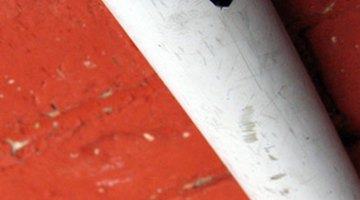How to Glue a Polyethylene Pipe
Polyethylene pipe, used for water supply lines, drainage pipe gas and sewer hook-ups, offers a durable flexible alternative to metal and hard plastic pipe. Polyethylene pipe does not fracture or break during freeze/thaw weather cycles due to its expanding nature.

Polyethylene pipe resists corrosion and does not degrade during use making it an economically sound choice. Polyethylene, formed into fittings, valves and pipe, requires a special bonding agent to join pieces together tightly.
Things You Will Need
- Rag
- Fine-grit sandpaper or steel wool
- Polyethylene adhesive
-
Wipe the ends of the pipe and insides of valves or fittings to remove dirt, dust and debris.
-
Sand the outer ends of the pipe and the insides of the valves or fittings with fine-grit sandpaper or fine-grade steel wool to rough up the smooth exterior/interior coating, which ensures a good bonding surface.
-
Wipe away polyethylene sanding dust burrs on the ends of a cut pipe with a rag.
-
Squeeze the tube or load a caulking gun with polyethylene adhesive to apply a bead around the pipe end. Use only adhesives designed specifically for polyethylene joining.
-
Insert the end of the pipe into the coupler or fitting within 1- to 2-minutes. Allow the joint to dry for 5-minutes before using.
Tip
Consider using barbed fittings and clamps if adhesives are not available. Use polyethylene adhesive in wet or dry conditions.
The Drip Cap
- Polyethylene pipe, used for water supply lines, drainage pipe gas and sewer hook-ups, offers a durable flexible alternative to metal and hard plastic pipe.
- Polyethylene, formed into fittings, valves and pipe, requires a special bonding agent to join pieces together tightly.
- Insert the end of the pipe into the coupler or fitting within 1- to 2-minutes.
References
- "Working With Plastics"; Time Life Editors; 1982
Writer Bio
Sal Marco began writing professionally in 2009. He has written many online home improvement articles based on his more than 20 years of experience in the home improvement and building industries. He has worked as both part of a team and as a site supervisor. Marco has a Bachelor of Science in management science from Kean University.
Photo Credits
- religious symbol image by askthegeek from Fotolia.com
- religious symbol image by askthegeek from Fotolia.com
More Articles



